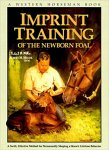Deze titel kan niet worden besteld.
Deze titel kan nu niet besteld worden. Probeer het later opnieuw
Deze titel kan nu niet besteld worden. Probeer het later opnieuw
Miller , Robert M. - IMPRINT TRAINING - Of The Newborn Foal
| Schrijver: | Miller , Robert M. |
|---|---|
| Titel: | IMPRINT TRAINING - Of The Newborn Foal |
| Taal: | Engels |
| Uitgever: | Western Horsman, 1991 Gesigneerddoor de schrijver |
| Bijzonderheden: | Grote paperback, 152 pag., ISBN 0911647228. wat uiterlijke gebruikssporen |
| Prijs: | € 14,00 (Excl. verzendkosten) |
| Meer info: |
IMPRINT TRAINING - Of The Newborn Foal,
Here is a how-to book for hands-on horse people, especially those who work with foals. The book explains procedures in step-by-step format with helpful black-and-white photos. The reader learns how to lay the foundation of much of what the foal will need to know to grow into a useful and manageable horse. Imprint training makes the foal – and later the horse – safer, quieter, and easier to handle. Large paperback, Dr. Miller is one of the leading advocates and educators on the concept of imprint training of foals. An overview of this technique is provided below. Imprint Training - An Overview Imprint training offers a singular opportunity to permanently mould a horse's personality. For a short time, the new born foal is programmed to imprint stimuli. The right procedures at the right time yield dramatic results. There is no time a horse will learn faster. Advantages Imprint training can help ease handling, enhance later training efforts and reduce injuries. It shapes behavior in the following ways: 1) Bonding with the imprint trainer. Immediately postpartum, the foal bonds simultaneously with its dam and with one or more persons handling it. Such foals see humans, not as predators, but as fellow horses. 2) Submission, but not fear. During imprint training, the foal cannot escape (its natural method of survival) exposure to frightening stimuli. As a result, it becomes dependent and submissive in its attitude. The foal sees the trainer as a dominant horse or herd leader. Psychologically, this is the ideal relationship between horse and human. We must have submissiveness in a horse if he is to work for us. But, the submissiveness should be created not by fear (a predatory role) but by dependence (a dominant leader role). 3) Desensitization to most sensory stimuli (visual, auditory, tactile, and olfactory). Most parts of the body, including all body openings, are desensitized. Rapid, repetitious stimuli (flooding) are used until the foal is habituated, i.e. permanently non responsive to those stimuli. Loud noises, fluttering objects or being touched anywhere on the body will thereafter be calmly tolerated. 4) Sensitizing to performance related stimuli. Specifically, the foal can be taught to respond (rather than habituated) to head and flank pressure. The responsiveness allows control over the fore and hind quarters. The foal will lead where directed, and will move its hind end laterally in response to the touch of a finger in the flank region. This is best taught on the day after birth, after the foal is on its feet. Some believe that early bonding between the foal and humans will produce a "pet" foal. They believe that early foal-human bonding will produce a spoiled horse, indifferent to stimuli, which will lack the flightiness "necessary" to race or perform well. This is nonsense. Imprint training, properly performed, will enhance a horse's relationship with humans. It will teach it "good manners" and increase its responsiveness to stimuli that will later improve its performance. The only "disadvantage" of imprint training is that, since it is best started immediately post-partum, the mare must be brought in for foaling. This is actually desirable, because it allows rapid identification of any obstetrical problems. It also requires that the Broodmare be gentle and well mannered. If she is not, it is better to correct before the mare foals, or, better, before she is bred. One should not expect to turn out docile, well mannered foals if one doesn't have a well mannered mare. Yet, some people seem to take pride in owning untrained, ill mannered broodmares. To me, poor manners indicate ownership by an inept horseman. An enhanced relationship I first became aware that neonatal foals can be trained and their behavior indelibly shaped, about 30 years ago. Subsequently, a behavior shaping routine evolved which I call "imprint training". I have no illusions that the training of new born foals is a new idea. In fact, there is no doubt that human beings have done this for thousands of years. All I have done is ritualized the procedure, given it a name, attempted to scientifically explain why it is so effective, and publicly promoted and encouraged its use because it enhances the relationship between horse and human, and, from a veterinarian standpoint, greatly facilitates the practitioner's job. Ill mannered horses are the bane of the horse industry. If you can imprint train your foals, this problem will be minimized. Imprint training is now commonly used all over the world. Since imprint trained horses are more manageable, far fewer injuries occur to horses and people. It has made life easier for both horse and horse handler. |
DE REKENING WIL NOG WEL EENS IN DE SPAM BELANDEN DUS ALS u BINNEN 3 DAGEN NIETS HOORT KIJK DAAR DAN EVEN
Ankerboek is een Algemeen antiquariaat.
Ankerboek is een Algemeen antiquariaat.
De verkoper zal binnen 3 werkdagen contact met u opnemen om de koop verder af te handelen.

